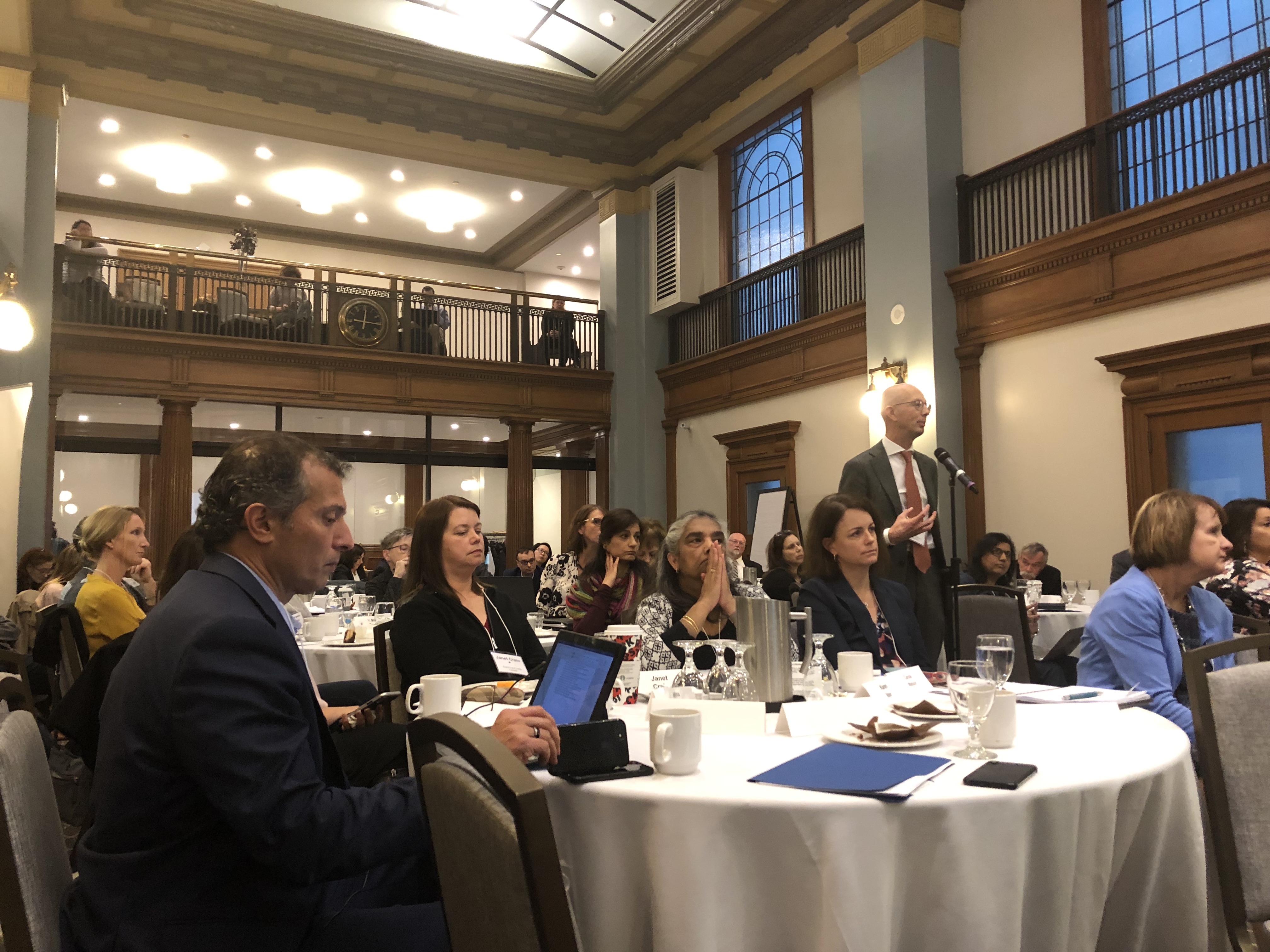HealthPRO Canada News
January 30, 2020
Industry Insights: Interview with CADTH President and CEO Dr. Brian O'Rourke

Dr. Brian O’Rourke is the President and Chief Executive Officer of CADTH, an independent, not-for-profit organization. Created by Canada’s governments in 1989, CADTH helps governments and healthcare providers make informed decisions about the optimal use of drugs and medical devices in our healthcare system.
After a multi-decade and diverse career which includes over 10 years of service with CADTH, and 32 years in the military, Dr. O’Rourke has announced that he will be retiring at the end of March 2020. HealthPRO had a conversation with Dr. O’Rourke about CADTH’s role in the healthcare system, the uptake of biosimilars and his advice/insights after over four decades in healthcare.
For those who may not be aware, can you tell us how CADTH helps healthcare providers make informed decisions about drugs and medical devices?
It helps to understand the distinction between what Health Canada does and what we do. Health Canada is the regulator – they’re responsible for the quality, safety and efficacy of drugs and devices. Although we work very closely with Health Canada, our role is to assess – through analysis of the evidence – the value or added value of a new or existing drug or medical device.
We have two portfolios – one related to pharmaceuticals and the other related to all the other health technologies, everything from medical, dental, and surgical devices to diagnostics and clinical interventions. And within those portfolios, we consider how effective the product is in comparison with what is currently being used to treat patients. Our ultimate goal is to give a recommendation to the health ministries and governments on whether or not they should reimburse that product – does it provide good value to taxpayers, and from a patient and provider perspective, does it make sense to use this new drug or new technology? With healthcare providers, we tend to go beyond just the recommendation on that individual drug or device – we’re there to give them advice on where that new drug or technology fits within the scope of tools, i.e., drugs, treatments and interventions, already available to them.

Lately, we’ve been hearing a lot about biosimilars — highly effective medicines that are very similar to high-cost biologic drugs which come from living organisms or their cells[1]. In September, BC announced that they’ll be switching patients from biologics to biosimilars and other provinces are watching closely. What role does CADTH play in the adoption of biosimilars?
When biosimilars started coming into the Canadian marketplace (2009 and 2010), the provinces and territories wanted us to review them. As we started doing more of them, we realized we were not providing any additional value to the information that was needed by the jurisdictions to make a decision on the funding of biosimilars. Health Canada was doing all of the appropriate analysis and looking at it from a manufacturing perspective. In fact, we were probably delaying access to biosimilars. So, this summer we took ourselves out of that space.
But we have a much broader role – in addition to providing recommendations as to whether or not to list this product, we also like to look at where the product fits in the clinical pathway and how to use it appropriately. With biosimilars, that means considering how they are being used in other parts of the world. We are also a great convener, bringing all of the stakeholders together – the manufacturers, the patients, the clinicians, and the policy makers – to talk about what they’re doing with biosimilars.
We have a very strong team of experts who are great at translating all of this information – if it’s clinicians we put more of a clinical lens on it; for patients, we help them understand what a biosimilar is.
We understand the issue of interchangeability – meaning is a biologic really interchangeable with a biosimilar – is a significant barrier at present. How can CADTH help overcome this barrier?
Typically, we don’t get involved with interchangeability. Even Health Canada doesn’t get involved in that – they’re looking at them more from a biological equivalent perspective, is the product similar? The interchangeability decisions rest with the provinces or the territories, it’s their responsibility to determine if the product is interchangeable. If they wanted us to bring together some information, we would do a very comprehensive literature search to help determine, for example, what would happen in the case of an interchangeability policy or the process used to switch patients from one product to another product. We would also look at what is happening with biosimilars across Canada and in other countries, are there examples we could build upon. We would compile all that information and then deliver it to the provinces to help inform their decision-making.

Can you tell me about the role real world evidence plays in bringing these products to market?
There are two components to that – real world evidence in general, and real world evidence specifically associated with biosimilars and biologics. Real world evidence is starting to increasingly come into play in the decision-making process. The current way of looking at new drugs is to pick a point in time and make a very binary decision: yes or no, or yes with conditions associated with that. There is still a lot of uncertainty when the regulators provide a marketing authorization, so now we are starting to look at products across their life cycle. We might give a conditional reimbursement recommendation and the conditions associated with that would be collection of real world data, and then do a reassessment of the value of that particular product once we’ve gathered that additional data. If the additional evidence demonstrates that there is minimal or no added value to the product, then we’d recommend that the price be re-negotiated or that it be delisted.
The regulators are looking at it in a similar way – they may have some of this real world data to supplement the clinical trials. A lot of it is in the post-market space – the data is collected, it’s reassessed, and a new decision can be made.
Now with the biosimilars, CADTH does not do that initial assessment. Most of that real world evidence review would be done by the regulator, Health Canada, both in their initial decision and any post-market analysis. They would be looking for any significant safety issues that are being identified in the real world.
Countries such as Denmark and the UK seem to be ahead in wide adoption of biosimilars. What lessons or insights can be gleaned from their progress that we could perhaps implement here in Canada?
Yes, absolutely, there are lessons from what they’re doing in these countries. Denmark and Norway are the two I’m most aware of and they’ve been very successful in instituting policies and practices, in some cases seeing up to 80 or 90 per cent uptake in the use of biosimilars. There are probably multiple factors contributing to that success – they are smaller countries geographically and population-wise with different healthcare systems from ours. They probably did a very good job engaging physicians early on and patient groups. We’re watching very closely and hoping to learn from them.
I understand that on Monday, November 18, 2019, CADTH and the pan-Canadian Pharmaceutical Alliance (pCPA) hosted an invitational national consultation in Toronto on the use of biosimilars outside of oncology. How successful was this session in determining a strategy to enhance adoption of biosimilars in Canada?
It’s too early to tell, but I think it will have a big impact. It was a great opportunity to build on CADTH’s convening role and bring various stakeholders together. The pan-Canadian Pharmaceutical Alliance (pCPA) first asked us to do a survey, so we set up a number of interviews with key informants across the country and that’s helping to build evidence on the situation in Canada.
Then we brought together over 100 people representing 35 organizations or patient groups, clinical groups, HealthPRO, private and public payers, and the representatives from both the reference biologic pharmaceutical companies as well as the biosimilar industry. All of the key stakeholders were together at the same time, learning about how other countries are doing it and how we can put policies in place to promote the use of biosimilars in Canada. Certainly, we know that both BC and Alberta have put some policies in place; now it’s whether other jurisdictions are ready to do that, do they need more information. We’re now putting all of that together into a coherent summary of the proceedings.

Canada has very good oversight of drugs and medical devices through Health Canada. Would you say that the role of CADTH has changed over the years based on what is happening in pharmacology and with health products?
The biggest change is the collaboration that now happens between regulators and the HTA community. Ten or 15 years ago we wouldn’t even talk to each other, we each had our own role to play and there wasn’t a good understanding of what each other did. That has changed significantly. CADTH has all kinds of wonderful interaction and joint initiatives with Health Canada and to me this is the appropriate way to go. They’re responsible for the quality, safety and efficacy of products and we look at the value of those products.
In the past it was a very sequential process – Health Canada would do their review, the decision would take 6-12 months, and then the manufacturer would send it to us. Another six months would pass for our analysis, then the price negotiation and on to the jurisdictions for their decision and listing. All of it meant there was a long period of time before patients could access those medications.
Now we’ve shortened that timeline because we start our work at approximately the same time as Health Canada and as soon as they’ve made a decision, within days or weeks we can come up with our recommendation. This speeds up the process of access and is a shining example of the benefits of collaboration.
On a personal note, I understand you will be retiring early next year. Based on your nearly four decades in the healthcare industry, is there any advice or any insights you’d like to share?
I feel very fortunate to have had fulfilling and quite diverse career experiences in healthcare. From starting as a pharmacist, my love of working with patients and directly impacting their lives, then to my time in the military from a public service perspective, and finally working at CADTH. Having this second career at CADTH has been extremely satisfying – I really believe in the work that we do in helping governments and clinicians and patients make good decisions on drugs and technologies.
In terms of advice, in the talks I have been giving in Canada and around the world, I refer to what’s coming in healthcare as the perfect storm of challenges for governments (the public payers) and this is happening in every country around the world. We’re seeing extremely robust pipelines of drugs and disruptive medical devices coming on the market and patients are demanding early and equitable access to these promising (and very expensive) treatments.
The fact that governments have a finite capacity to deal with this disruption has created a greater need for the kind of work CADTH does and also a change in how we do things: moving from the role of just doing the assessments to greater engagement with stakeholders (particularly patients and clinicians), to doing our reviews over the life cycle of the technologies, and then being involved in the greater mobilization of knowledge and helping with implementation.
I don’t want to paint a bleak picture. There are so many good things going on – innovation, new drugs, curative treatments for patients – these are all good things, but how do we manage them? How do we make the best decisions on spending our limited taxpayer dollars to get the best value to all patients and Canadians in general? To me, it’s an exciting opportunity for an organization like CADTH in helping to manage this perfect storm.
[1] https://www.canada.ca/en/health-canada/services/drugs-health-products/biologics-radiopharmaceuticals-genetic-therapies/applications-submissions/guidance-documents/fact-sheet-biosimilars.html#a2


